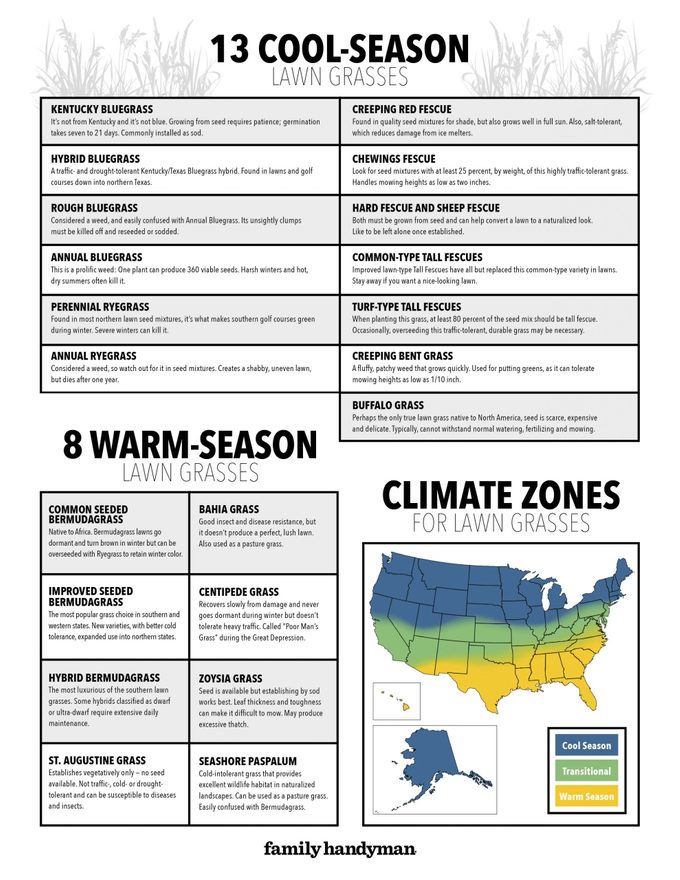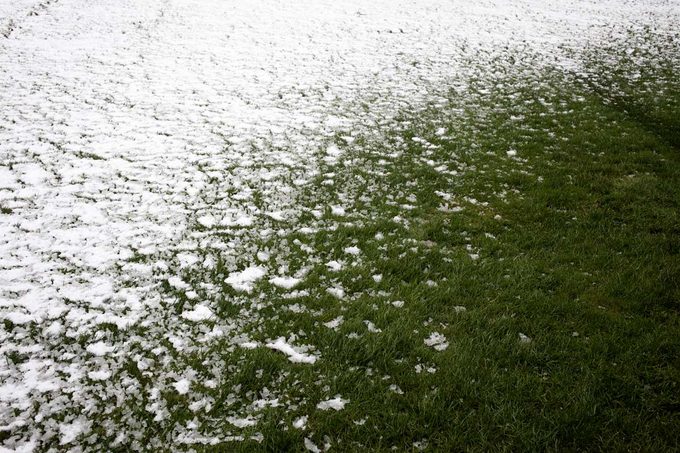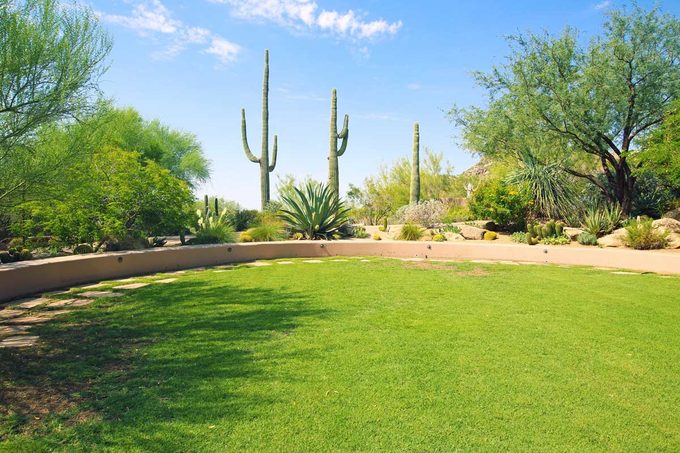Pictures of Different Kinds of Grass
Get to know the most common turf grasses you'll see in lawns, ballfields and parks across the U.S., and discover which one would work best in your yard.
When you choose the best grass for your climate, conditions and lifestyle, you greatly improve your chances of growing the lawn you've always wanted.
ⓘ
A Brief Glossary of Grass Terms
Cool-season grass: Grows best in Northern climates, higher elevations and other temperate regions where winters are cold and summers are mild.
Warm-season grass: Grows best in Southern and Southwestern climates where ambient temperatures seldom, if ever, dip below freezing. Thrives in warm, humid conditions.
Tillers: Singular vegetative shoots originating from the base of a "mother" grass plant consisting of a stem and leaf blades.
Rhizomes: Underground stems that help some grasses spread.
Stolons: Aboveground runners or lateral stems that help some grasses spread.
Bunch type: Grasses that grow from tillers that sprout from the base of an individual grass plant.
 Family Handyman
Family Handyman
Download the PDF version of this chart.
13 Cool-Season Lawn Grasses
 Emanuele Camerini / EyeEm/Getty Images
Emanuele Camerini / EyeEm/Getty Images
Kentucky Bluegrass (Poa pratensis)
ID It: Medium- to dark-green color; medium texture; boat-shaped leaf tip; spreads by rhizomes.
Where You'll Find It: Almost everywhere north of Interstate 80, preferring mild summers, cold winters and full sun.
Why Plant It: Because this durable, winter hardy grass recovers quickly from drought and wear damage. It is compatible with other cool-season grasses and quickly forms a tightly knit sod.
What to Know: It did not originate in Kentucky (it's native to Europe) and it's not blue. Primarily grown from seed, which requires patience because germination takes seven to 21 days. It is commonly installed as sod.
Hybrid Bluegrass (Poa arachnifera x Poa pratensis)
ID It: Dark-green color; medium-fine leaf texture; boat-shaped leaf tip; spreads by rhizomes.
Where You'll Find It: Mostly in the transition zone, preferring hot, dry, shady conditions.
Why Plant It: Because its deep-penetrating root system provides improved heat and drought tolerance in Northern lawns.
What to Know: This is a hybrid cross of Kentucky Bluegrass and Texas Bluegrass, often found blended with turf-type tall fescue seed. You'll find traffic tolerant Hybrid Bluegrass lawns and golf courses all the way down into northern Texas.
Rough Bluegrass (Poa trivialis)
ID It: Light-green color; soft leaf blades; spreads by stolons; often shows up in lawns as unsightly clumps.
Where You'll Find It: In U.S. regions that stay cool and wet and shady over-watered lawns.
Why Plant It: Don't! Plant only as a last resort for moderate shade in moist locations.
What to Know: Generally considered a weed, some seed companies still use it in shade grass mixtures. There is no known selective control, so patches, which are easy to confuse with Annual Bluegrass, must be killed off and reseeded or sodded.
Annual Bluegrass (Poa annua)
ID It: Appears as apple-green patches of all sizes; often displays whitish seedheads; bunch-type grass.
Where You'll Find It: Everywhere. It's on all seven continents and is one of the top five most common plants on Earth, preferring moist, cool areas and heavy soils. You'll see it in most golf courses and residential lawns that receive lots of fertilizer and water.
Why Plant It: Don't. It's a weed.
What to Know: Don't buy cheap grass seed because it probably contains Annual Bluegrass. Sometimes confused with Rough Bluegrass and all Bentgrasses, one plant of this prolific seeder can produce 360 viable seeds. Harsh winters and hot, dry summers will often kill it.
Perennial Ryegrass (Lolium perenne)
ID It: Medium-green color; shiny underside of leaf blades; bunch-type growth.
Where You'll Find It: Sunny locations, especially in Southern states where it's used as a temporary winter grass.
Why Plant It: Because it is fast to establish and has improved wear tolerance.
What to Know: Perennial Ryegrass, which looks like Kentucky Bluegrass, is found in most Northern lawn seed mixtures. It's widely used on golf courses and ball fields; it's what makes Southern golf courses green during the winter. Note that extremely severe winters can kill it.
Annual Ryegrass (Lolium multiflorum)
ID It: Apple-green color; coarse texture; germinates and grows faster than other grasses; bunch-type growth.
Where You'll Find It: Throughout the U.S., often in pastures.
Why Plant It: Because it's cheap and you don't care how your lawn looks. Annual Ryegrass is also good as a nurse crop to protect slower-growing grasses as they establish, and where temporary groundcover is desired.
What to Know: It's pretty much a weed, so resist using seed mixtures containing it. It grows much faster and taller than other grasses and creates a shabby, uneven lawn. Luckily, it only grows for one year and then dies.
Creeping Red Fescue (Festuca rubra ssp. rubra)
ID It: Medium-green color; extremely fine texture; spreads by rhizomes; grows slowly once established.
Where You'll Find It: Throughout the Northern U.S. at shady roadside and utility areas with infertile, sandy soil, and in low-maintenance lawns.
Why Plant It: Because you want to expand the overall diversity of your medium- to heavily shaded lawn, especially if you're trying to cut back on fertilizer and water use.
What to Know: You will find creeping red fescue in quality seed mixtures for shade, but it grows surprisingly well in full sun as well. It grows well with other Northern grasses and is salt-tolerant, which helps limit turf damage from ice melters.
Chewings Fescue (Festuca rubra ssp. commutata)
ID It: Medium- to dark-green color; extremely fine texture; very good turf density; bunch-type growth habit.
Where You'll Find It: Throughout the Northern U.S., in well-maintained lawns with well-drained soil with full sun to heavy shade.
Why Plant It: Because you want to expand genetic diversity, improve lawn density and reduce weeds in your shady lawn.
What to Know: Look for seed mixtures with at least 25 percent by weight of this highly traffic-tolerant fine fescue. It grows well with Kentucky Bluegrass and can handle mowing heights as low as two inches.
Hard Fescue (Festuca trachyphylla) (Festuca ovina var.)
ID It: Medium-dark to bluish-green leaf color; very fine texture; can get clumpy in low-maintenance lawns; bunch-type growth habit.
Where You'll Find Them: Throughout the Northern U.S., in cemeteries, old parks, naturalized areas, roadsides and other no-mow areas with full sun to heavy shade.
Why Plant Them: Because these grasses can help convert a lawn to a naturalized look and are perfect if you don't want to water, fertilize or even mow your lawn.
What to Know: They're not for everyone. You'll have to grow from seed because you won't find these grasses as sod. Some have a unique look due to a fine leaf texture and blue-green color. Once established, they like to be left alone.
Common-Type Tall Fescues (Festuca arundinacea)
ID It: Coarse, weed-like appearance; rigid leaf blades; bunch-type growth.
Where You'll Find Them: Throughout the Transition Zone in pastures, native areas, roadsides, old lawns, parks and common grounds.
Why Plant It: Because this grass is less expensive than turf-type tall fescue, if turf quality and density isn't important, you'll save money.
What to Know: Stay away if you want a nice-looking lawn. Improved "lawn-type" tall fescues have all but replaced the "common-type" variety in lawns. These grasses are not winter hardy and should not be used in Northern states. Some named varieties are K31, Alta and Fawn.
Turf-Type Tall Fescues (Schedonorus arundinaceus)
ID It: Dark-green color; medium-textured with rigid, pointy leaves; deep, penetrating root system; bunch-type growth.
Where You'll Find Them: Throughout the transition zone in actively used, low to moderately maintained lawns, playgrounds and ball fields with full sun to moderate shade and all soil types.
Why Plant Them: Because you want a take-it-easy lawn requiring less fertilizer and water, but traffic tolerance and durability are important.
What to Know: To grow this grass, at least 80 percent of the seed mix by weight should be tall fescue. You may need to overseed occasionally to maintain density. They can be slow to recover from wear. New varieties are better adapted to extreme Northern winters, and most contain the beneficial fungus endophyte that improves resistance to lawn insects.
Creeping Bentgrass (Agrostis stolonifera)
ID It: Olive to lighter green color; very fine texture; soft, velvety touch; spreads by stolons.
Where You'll Find It: Mostly in the Northern two-thirds of U.S. states, in mostly sunny areas with well-drained, lighter soils, especially golf courses and bowling lawns.
Why Plant It: Because you want a home putting green and you're up for a challenge. It has limited application for residential lawns.
What to Know: It shows up as a fluffy, patchy weed that grows quickly and can be confused with Rough Bluegrass and Annual Bluegrass. It can tolerate mowing heights as low as 1/10-inch on putting greens.
Buffalograss (Buchloe dactyloides)
ID It: Grayish-green color; medium to fine-textured leaves; open, thin turf density; spreads by stolons.
Where You'll Find It: Throughout the Canadian plains to southern Texas where it's dry, with limited rainfall and full sun, in native, passively used lawns and general turf areas.
Why Plant It: Because you want a native, low-maintenance lawn so you don't have to use fertilizer, water and pesticides.
What to Know: Seed for this, perhaps the only true lawn grass native to North America, is hard to find and expensive. While tolerant of many environmental conditions, Buffalograss can be easily squeezed out by more aggressive lawn grasses. Normal watering, fertilizing and mowing can be too much for it.
8 Warm-Season Lawn Grasses
 TriggerPhoto/Getty Images
TriggerPhoto/Getty Images
Common Seeded Bermudagrass (Cynodon dactylon)
ID It: Dull, light-green color; medium leaf texture; loosely netted, lacks density; spreads by rhizomes and stolons.
Where You'll Find It: In full-sun native grass areas, roadsides and older Southern lawns.
Why Plant It: Because turf quality isn't important and you want to save money.
What to Know: Oddly, Bermudagrass is native to Africa, not Bermuda. Bermudagrass lawns go dormant and turn brown during winter and can be overseeded with Ryegrass to retain winter color.
Improved Seeded Bermudagrass (Cynodon dactylon)
ID It: Darker green color; medium leaf texture; superior turf density vs. common types; deeper penetrating roots.
Where You'll Find It: Wherever there is full sun and better lawn quality is desired, such as well-maintained ball fields, golf courses, parks and residential lawns.
Why Plant It: Because you want better-looking grass that's resistant to disease and insects, traffic-tolerant and cold hardy.
What to Know: Bermudagrass is the most popular grass choice in Southern and Western states. New varieties, with much better cold tolerance, have expanded its use into Northern states. It is sometimes confused with crabgrass because its leaves and seed heads look similar. The first Improved Seeded Bermudagrass was Guymon, released in 1987.
Hybrid Bermudagrass (C. dactylon x C. transvaalensis)
ID It: Dark-green color; superior turf density; fast-growing; spreads by stolons and rhizomes.
Where You'll Find It: In Southern golf course putting greens, high-end university and professional ball fields, elite lawns and commercial properties with full sun.
Why Plant It: Because you want superior turf quality, traffic tolerance, speed of recovery and turf density so you can have the finest looking lawn in the neighborhood.
What to Know: This is the luxury car of Southern lawn grasses. Some hybrids are classified as dwarf or ultra-dwarf, but they require extensive daily maintenance.
St. Augustinegrass (Stenotaphrum secundatum)
ID It: Medium- to dark-green color; very broad, flat leaf blades with blunt, rounded tips; spreads by stolons.
Where You'll Find It: Humid and tropical regions from Florida's Atlantic Coast to the Texas Gulf Coast, in well-maintained areas including lawns, parks and commercial properties with full sun to moderate shade.
Why Plant It: Because you have a moderately low-maintenance site in a hot, humid location with some shade.
What to Know: This grass, native to the Gulf Coast, West Indies and Western Africa, establishes vegetatively — no seed is available. It's not traffic-, cold- or drought-tolerant and it can be susceptible to diseases and insects.
Bahiagrass (Paspalum notatum)
ID It: Dark green color; medium-coarse leaf texture; deep root system; slow to establish from seed; slow growing; spreads by weak stolons.
Where You'll Find It: Throughout Florida's Atlantic Coast to the Texas Gulf Coast, and in hot, dry regions where there is full sun to light shade.
Why Plant It: You live in a hot, dry region with limited access to water, and/or your soil is heavy and drains poorly, and you want an easy-care lawn.
What to Know: Bahiagrass is also used as a pasture grass and it can produce unsightly seed heads. There are some new lawn-type varieties available, and it has good insect and disease resistance. However, it's not for those who want a perfect, lush lawn.
Centipedegrass (E remochloa ophiuroides)
ID It: Light apple-green color; medium-coarse texture; shallow root system; spreads by stolons.
Where You'll Find It: Throughout the Florida Atlantic Coast to the Texas Gulf Coast in low-maintenance lawns where water is plentiful, the soil is sandy and acidic and there is full sun to light shade.
Why Plant It: Because you want to mow less and your soil is really sandy and infertile.
What to Know: Centipedegrass is native to China and Southeast Asia. During the Great Depression, it was referred to as "Poor Man's Grass." It doesn't tolerate heavy traffic, recovers slowly from damage and never goes dormant during the winter.
Zoysiagrass (Zoysia japonica)
ID It: Light- to medium-green color; medium to coarse leaf texture; forms dense sod; deep penetrating root system; spreads by rhizomes and stolons.
Where You'll Find It: Throughout the hot, dry areas of the transition zone and West Coast in well-maintained lawns and commercial properties with full sun to light shade.
Why Plant It: Because you want quality heat- and cold-tolerant turf for your actively used lawn.
What to Know: Native to Asia, seed is available, but establishing by sod works best. Leaf thickness and toughness can make it difficult to mow. It can produce excessive thatch, requiring occasional dethatching.
Seashore Paspalum (Paspalum vaginatum)
ID It: Medium green; medium to coarse leaf texture; spreads by both rhizomes and stolons.
Where You'll Find It: Throughout the Gulf Coast and other salty areas in residential lawns, ball fields and golf courses with full sun to medium shade and adequate moisture.
Why Plant It: Because you want an elite-quality lawn that will tolerate low mowing and heavy use, even though your soil and irrigation water source has a high salt concentration.
What to Know: Seed is not available, so this cold-intolerant grass is established vegetatively by sod or stolons. It provides excellent wildlife habitat in naturalized landscapes, can be used as a pasture grass and can be confused with Bermudagrass.
Pictures of Different Kinds of Grass
Source: https://www.familyhandyman.com/article/turf-grass/
0 Response to "Pictures of Different Kinds of Grass"
Post a Comment